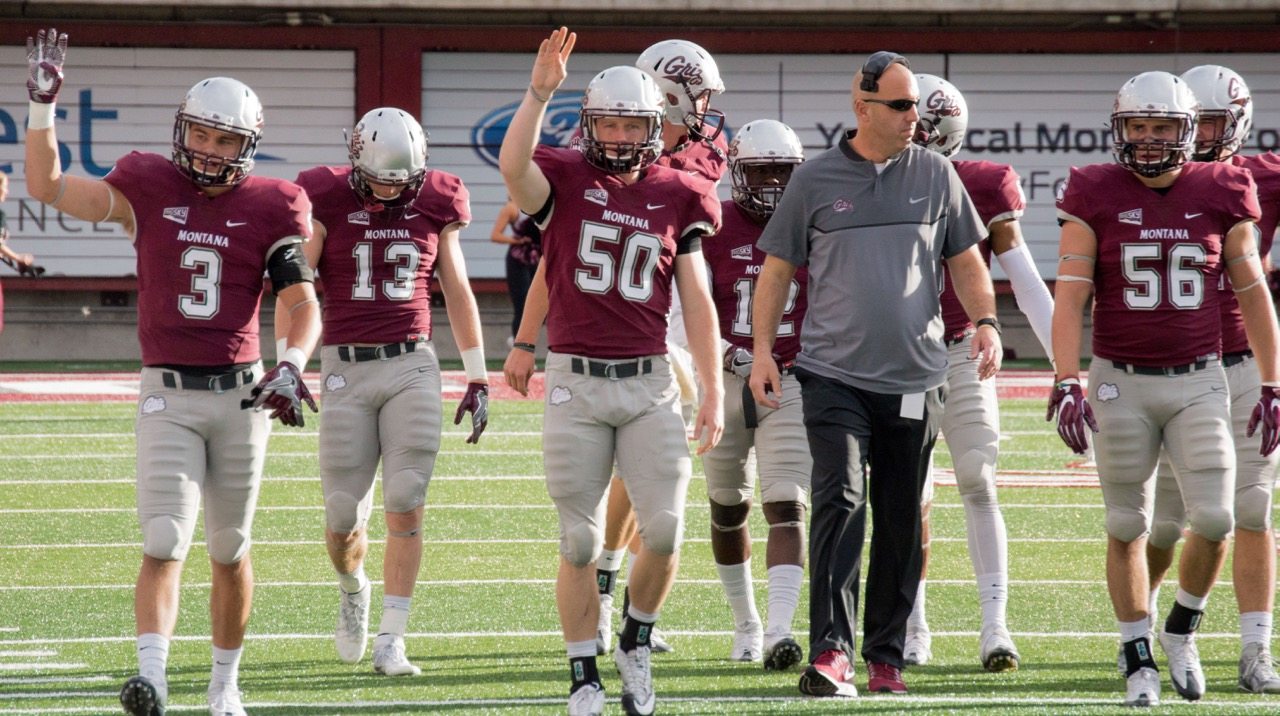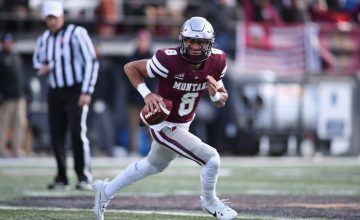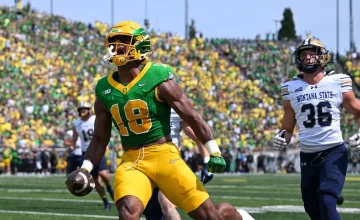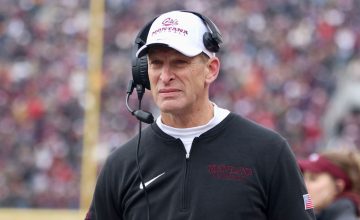It’s a Thursday night before homecoming. Aaron Held has a few important items on his agenda. Before he can can make it to his special teams meeting or the Grizzlies’ team dinner on this celebratory week, he has a more pressing matter at hand. The next morning Montana’s senior long snapper has a test filled with complex items he must register in his brain to have any chance of faring well. Since arriving on campus from Sacramento in 2012, that hasn’t been much of a problem for Held, a double major in exercise science and human biology who has taken a keen interest in structural and functional neuroscience since taking a class taught by UM professor Jesse Hay almost a year ago.
If you just rolled over structural and functional neuroscience without much of a thought to how difficult the field of study is, here’s the center’s brief mission statement from the University of Montana website: “To foster multidisciplinary research and training at the interface of molecular neurophysiology, cellular neurobiology, and molecular neuropharmacology. A diverse group of faculty representing synthetic chemists, molecular biologists, physiologists, and clinicians form a dynamic and collaborative neuroscience research group.”
Huh?
As Held focuses on his notes and readings, Montana place kicker Tim Semenza is thinking the same thing.
“He tried to read to me the sequence that he had to memorize and like three words in I was completely lost,” Semenza recalled with a laugh. “He was like, ‘Yep, that’s what I have to memorize for tomorrow.’ I don’t know how he does it.”
He may have one of the more simple looking jobs on the team — just fire that ball back between your legs to the holder and let the kicker do the rest — but Held’s academic studies have steered him into a world of complex science that will eventually lead him into the medical field of his choosing. He’s Davidson Honors College student who was awarded a summer undergraduate research fellowship at Montana’s Center for Structural and Functional Neuroscience. There, he aided Hay’s research into a certain protein that could eventually help in finding a cure for cystic fibrosis.
It helped earn Held one of his more cherished academic accomplishments.
“I do have a published paper, which is cool to say: I am a published scientist,” Held said.
Held tried to distill the work into layman’s terms with the following explanation (good luck): “It’s on cell vesicle transport and the specific proteins involved in it. Basically what we did is there is a protein that no one really knew what its function was. We had a hypothesis of what its function might be and we did a bunch of tests on it and found that our hypothesis seemed to be true from the test that we did. It was pretty cool. If you look up that paper and try to read it — I tried to read it to somebody who didn’t really have a science background — they had no idea what it said.
“Basically we just had an idea that the protein had something to do with cell vesicle transport from the endoplasmic reticulum to the golgi. What we ended up finding is that it was a negative regulator from the ER to golgi transport. There is a whole complex that Jesse Hay has been studying since he got out of his post doctorate. He and other people in Japan and other places have been studying (this) and discovered this complex that does the actual transport itself. We basically discovered that this protein that we found that was separate from that complex that no one had any idea what it did was a negative regulator of that complex that allowed all that cell vesicle transport to go through.”
What you need to know is that the certain protein’s role could help scientists better understand the mechanism and hopefully someday cure a disease that affects more than 30,000 Americans.
All in a day’s work for Held.
During the long days that drag on between the end of spring drills and the beginning of fall camp, you may remember videos Montana punter Eric Williams posted to his Twitter account. One popped up in May of Williams kicking a football off a tee from one sideline to the other, where his kick violently landed into a plastic trash can. About a month later from section 222 of Washington-Grizzly Stadium’s Majestic Plaza, Williams posted another of him punting a ball that traveled along a steep arc until it crashed to the ground nearly three-fourths of the way across the turf.
“That was a bomb. … Oh my God,” says the guy recording Williams’ trick-shot.
What isn’t seen in these recordings are Held’s attempts at Twitter immortality. Just as Williams did, Held marched his way up into the stadium’s most recent seating expansion with four or five balls. Only his mission was to make long snapping interesting.
He placed a trash can somewhere along the 40-yard line and threw footballs two-handed between his legs at the tiny target. On his fourth or fifth attempt — he doesn’t remember — he came a foot away from dropping it into the trash can.
“I have video,” Held says, making sure what was nearly an impossible feat couldn’t be objected to.
Though he isn’t able to do this during practice, Held has found ways to entertain himself — and perfect his craft — when he and the other specialists are left to themselves as the the rest of the team practices. To the untrained eye it may look like Held and the kickers and punters are just goofing off, but what is actually taking place is a series of creative opportunities to challenge their skills.
While Semenza, Williams and Brandon Purdy are kicking at light posts and whatever else they can find to test their accuracy, Held and fellow snapper Caleb Mitchell are snapping balls at tiny little cubby holes in the padding on the west sidelines. The two snappers have found that one hole is the perfect height to practice point after and field goal snaps, while the other is just about where you’d want to spin a snap to a punter.
“We will see who can make it in the box or who can hit certain points on the wall,” said Mitchell, a freshman who has served as Held’s understudy.
Held says he can stick the ball in the lower cubby hole once every 12 or 15 times. The other hole, at the punter’s height, is smaller and Held said he’s only been able to drill a football into it a handful of times.

Montana senior long snapper Aaron Held (50), pictured here against Cal Poly in 2015/ by Brooks Nuanez
Whatever his success rate in practice, it must be good enough for Montana’s coaches. After all, since sitting out the 2012 season as a redshirt, Held has started every game he’s played in, a streak of 42 consecutive starts that is far and away the most on the Griz.
That followed a high school career that ended with Held as the nation’s 32nd-ranked snapper. He sent his tape to a few schools who said he could try out and to one — Montana — that reserved a spot on the team.
But what’s the big deal? He’s just a long snapper — it doesn’t even look that difficult.
“To an extent it is a little simpler than other positions,” Held said. “But it’s a lot more complicated than just throwing the ball between your legs.”
Held’s field of play and field of study hold interesting juxtapositions and similarities. Unlike his academics, snapping looks easy — it is just throwing the ball between your legs. But like his academics, it is incredibly precise.
“We’re aiming to throw a ball at 15 yards in about 0.7, 0.65 seconds into a portion of the human body that is only about 1-foot wide and 1-foot tall,” Held said.
And if you wanted him to break down the precise biomechanics of it, Held said that after a little brushing up, he could do that too.
Long snappers are probably the most overlooked members of any team. Sometimes not even the people looking for them know exactly who they’re looking for. Take for instance a recent discussion between a reporter and one of Montana’s sports information directors, who became rightfully confused when the reporter incorrectly identified his subject.
“Who the hell is that?” the SID responded, his face contorted like he just bit into a lemon.
“You know, the long snapper,” the reporter responded sheepishly, realizing his egregious mistake. “He’s started every game he’s played in — 42 in a row. How many long snappers are there?”
“You mean Aaron Held?” responded the SID.
“Yes. …” said the reporter, burying his face in his notebook.
Rarely do well-behaved long snappers make history. That’s exactly what Held has been. In a position that can quickly throw a team into a state of disarray if it hasn’t taken the proper precautions to guard itself against losing the most overlooked member of the team, Held has been as reliable as any other player.
“I don’t have to worry about Aaron at all, which is awesome because it takes one more thing out of what we have to do,” Semenza said earlier this week. “We have things we have to worry about back there and we don’t want to be worrying about the snap or where the hold is.”
Held’s calming influence has already proved helpful this year. Semenza said Held’s maturity and experience has aided in what was until recently a wildly successful year for the freshman kicker.
And Semenza expects that Held’s presence will be a factor as the kicker tries to bounce back from a difficult two weeks.
“Being a kicker this week was tough, we had a tough weekend, I’m not going to lie,” Semenza said, referencing the two missed PATs and blocked field goal attributed to Montana’s two kickers. “But having him on the sideline, you know, a veteran, when you come off the field and he’s there picking you up telling you to forget about it, to pick your head up and move onto the next kick, he’s always reminding us about that. He’s been in all these situations; he’s seen everything. Having him as a mentor and someone to be there to pick you up when you’re down is huge. It’s been a great help.”
Photo attribution noted. All Rights Reserved.















